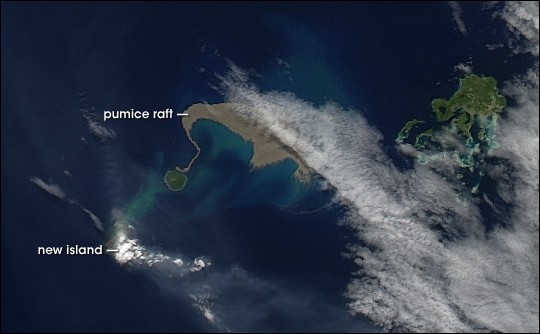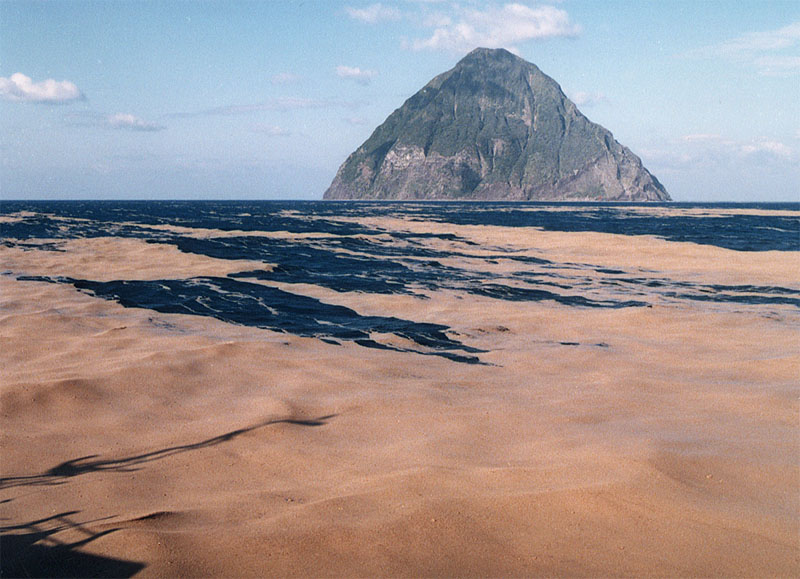pumice raft on:
[Wikipedia]
[Google]
[Amazon]
 A pumice raft is a floating raft of
A pumice raft is a floating raft of
 Pumice rafts drifted to
Pumice rafts drifted to
Pumice raft in South China Sea near Vietnam in August 1986Pumice rafts in Fiji produced by the eruption of Home Reef volcano, Tonga in 2006
Volcanoes Volcanology Rafts Floating islands
 A pumice raft is a floating raft of
A pumice raft is a floating raft of pumice
Pumice (), called pumicite in its powdered or dust form, is a volcanic rock that consists of highly vesicular rough-textured volcanic glass, which may or may not contain crystals. It is typically light-colored. Scoria is another vesicular v ...
created by some eruptions of submarine volcano
Submarine volcanoes are underwater vents or fissures in the Earth's surface from which magma can erupt. Many submarine volcanoes are located near areas of tectonic plate formation, known as mid-ocean ridges. The volcanoes at mid-ocean ridges ...
es or coastal subaerial volcanoes.
Biologists suggest that animals and plants have migrated from island to island on pumice rafts.
Pumice rafts have unique characteristics such as the highest surface-area-to-volume ratio known for any rock type, long term flotation and beaching in the tidal zone, exposure to a variety of conditions, including dehydration, and an ability to absorb many potentially advantageous elements/compounds. For at least these reasons, astrobiologist
Astrobiology, and the related field of exobiology, is an interdisciplinary scientific field that studies the origins, early evolution, distribution, and future of life in the universe. Astrobiology is the multidisciplinary field that inves ...
s have hypothetically proposed pumice rafts as an ideal substrate for the origin of life
In biology, abiogenesis (from a- 'not' + Greek bios 'life' + genesis 'origin') or the origin of life is the natural process by which life has arisen from non-living matter, such as simple organic compounds. The prevailing scientific hypothes ...
.
Notable examples
 Pumice rafts drifted to
Pumice rafts drifted to Fiji
Fiji ( , ,; fj, Viti, ; Fiji Hindi: फ़िजी, ''Fijī''), officially the Republic of Fiji, is an island country in Melanesia, part of Oceania in the South Pacific Ocean. It lies about north-northeast of New Zealand. Fiji consists ...
in 1979 and 1984 from eruptions around Tonga, and some were reportedly wide.
Volcanic activity in the South Pacific near Tonga on August 12, 2006 caused the emergence of a new island. The crew of the ''Maiken'', a yacht that had left the northern Tongan islands group of Vava'u in August, reported that they had seen streaks of light, porous pumice
Pumice (), called pumicite in its powdered or dust form, is a volcanic rock that consists of highly vesicular rough-textured volcanic glass, which may or may not contain crystals. It is typically light-colored. Scoria is another vesicular v ...
stone floating in the water—and then had "sailed into a vast, many-miles-wide belt of densely packed pumice". They went on to witness the ephemeral
Ephemerality (from the Greek word , meaning 'lasting only one day') is the concept of things being transitory, existing only briefly. Academically, the term ephemeral constitutionally describes a diverse assortment of things and experiences, fr ...
island known as Home Reef breaching the surface.
A very large pumice raft appeared near New Zealand
New Zealand ( mi, Aotearoa ) is an island country in the southwestern Pacific Ocean. It consists of two main landmasses—the North Island () and the South Island ()—and over 700 smaller islands. It is the sixth-largest island count ...
in August 2012. It was reported to be spread on an area long and about wide, with pumice blocks poking up to above the ocean surface. On 10 August 2012 a raft with an estimated area of was observed near Raoul Island
Raoul Island (''Sunday Island'') is the largest and northernmost of the main Kermadec Islands, south south-west of 'Ata Island of Tonga and north north-east of New Zealand's North Island. It has been the source of vigorous volcanic activity ...
, north-east of New Zealand by the Royal New Zealand Navy. A possible source for the pumice was the July 2012 eruption of Havre seamount
A seamount is a large geologic landform that rises from the ocean floor that does not reach to the water's surface (sea level), and thus is not an island, islet or cliff-rock. Seamounts are typically formed from extinct volcanoes that rise abru ...
in the Kermadec Islands north of New Zealand. (''See: 2012 Kermadec Islands eruption).''
In August 2019, a large floating pumice raft covering was discovered in the tropical Pacific Ocean near Late Island in the Kingdom of Tonga
Tonga (, ; ), officially the Kingdom of Tonga ( to, Puleʻanga Fakatuʻi ʻo Tonga), is a Polynesian country and archipelago. The country has 171 islands – of which 45 are inhabited. Its total surface area is about , scattered over in ...
. Sailors described a “rubble slick made up of rocks from marble to basketball size such that water was not visible,” as well as a smell of sulfur.
Sandy Island, a non-existent island near New Caledonia, was reported in 1876 by the whaling ship ''Velocity'' and subsequently included on some maps well into the 20th century. According to a team of University of Sydney scientists, it is possible that this false report may have been occasioned by pumice rafts being mistaken by the ''Velocity'' for dry land.
See also
*Curacoa volcano
Curacoa is a submarine volcano located south of the Curacoa Reef in northern Tonga. The reef is 24fm North of Tafahi in the Niua Islands. Eruptions were observed in 1973 and 1979 from two separate vents. The 1973 eruption produced a large raft ...
*Floating island
A floating island is a mass of floating aquatic plants, mud, and peat ranging in thickness from several centimeters to a few meters. Floating islands are a common natural phenomenon that are found in many parts of the world. They exist less co ...
*Lava balloons
A lava balloon is a gas-filled bubble of lava that floats on the sea surface. It can be up to several metres in size. When it emerges from the sea, it is usually hot and often steaming. After floating for some time it fills with water and sinks a ...
References
{{reflistExternal links
Pumice raft in South China Sea near Vietnam in August 1986
Volcanoes Volcanology Rafts Floating islands